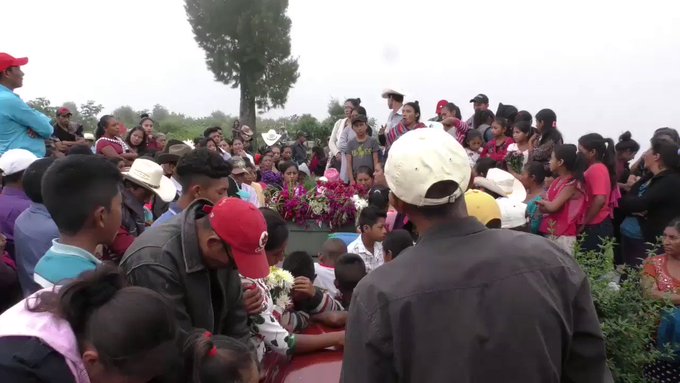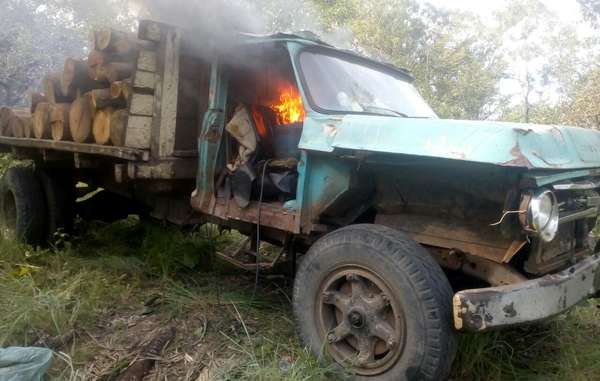
by Deep Green Resistance News Service | Aug 15, 2018 | Colonialism & Conquest
Featured image: The Guardians of the Amazon recently destroyed a logging truck they discovered in their territory. © Guardians of the Amazon
by Survival International
Warning: some people may find the details and image below disturbing
A leader of an Amazon tribe acclaimed for its environmental defenders has been killed, the latest in a series of deaths among the tribe.
The body of Jorginho Guajajara was found near a river in the Brazilian state of Maranhão. He was a leader of the Guajajara people, acclaimed internationally for their work as the ‘Guardians of the Amazon’ in the most threatened region in the entire Amazon.
It is not yet clear who killed him, but a powerful logging mafia has repeatedly targeted the tribe for its work protecting both its rainforest home, and the uncontacted members of a neighboring tribe, the Awá, who also live there, and face catastrophe unless their land is protected.
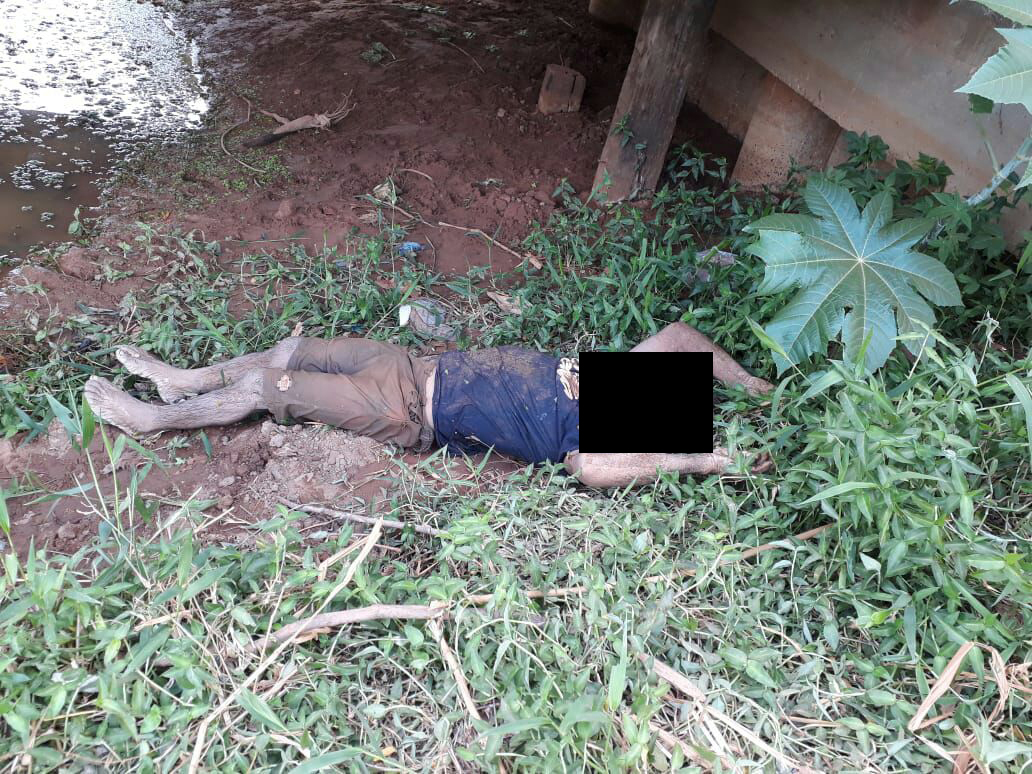
Jorginho Guajajara’s body was found near a river in the eastern Brazilian Amazon.
Confronted with official inaction, the tribe formed an environmental protection team named the Guardians of the Amazon to expel the loggers. Some estimates suggest up to 80 members of the tribe have been killed since 2000.
The murder of Jorginho Guajajara is further indication of the increasing volatility in this area. In May this year, a team from Ibama (Brazil’s environmental protection agency) and environmental military police were dispatched to the Guajajara’s Arariboia reserve, a rare move from the authorities.The Guajajara say: “Our uncontacted Awá relatives cannot survive if their forest is destroyed. As long as we live, we will fight for the uncontacted Indians, for all of us, and for nature.”
Survival International has protested to the Brazilian authorities about the wave of violence against the Guajajara, which has gone almost entirely unpunished.
Survival International Director Stephen Corry said today: “The Guardians of the Amazon face an urgent humanitarian crisis, and are fighting for their very survival. This small tribe of Amazon Indians are confronting an aggressive, powerful and armed logging mafia with close ties to local and national politicians. And they’re paying with their lives for standing up to them. They urgently need public support to make sure they survive.”
The Guardians of the Amazon
– The “Guardians of the Amazon” are men from the Guajajara tribe in Brazil’s Maranhão state who have taken it upon themselves to protect what remains of this eastern edge of the Amazon rainforest.
– They want to save the land for the hundreds of Guajajara families who call it home, and their far less numerous neighbors: the uncontacted Awá Indians.
– The Guardians say of their work: “We patrol, we find the loggers, we destroy their equipment and we send them away. We’ve stopped many loggers. It’s working.”
– The Guardians recently released video and images of a rare encounter with the uncontacted Awá living in Arariboia. Watch the footage here
– You can see videos of several of the Guardians talking about their work on Survival’s Tribal Voice site.
Arariboia
– The Arariboia indigenous territory comprises a unique biome in the transition area between the savannah and the Amazon rainforest.
– There are species here not found elsewhere in the Amazon.
– The land inside the indigenous territory is under threat from illegal loggers
– Brutal cuts in government funding to its indigenous affairs department FUNAI and tribal land protection mean the dangers are now even greater, as the area is not properly monitored or defended by the authorities.
– A powerful and violent logging mafia operates in the region, supported by some local politicians.
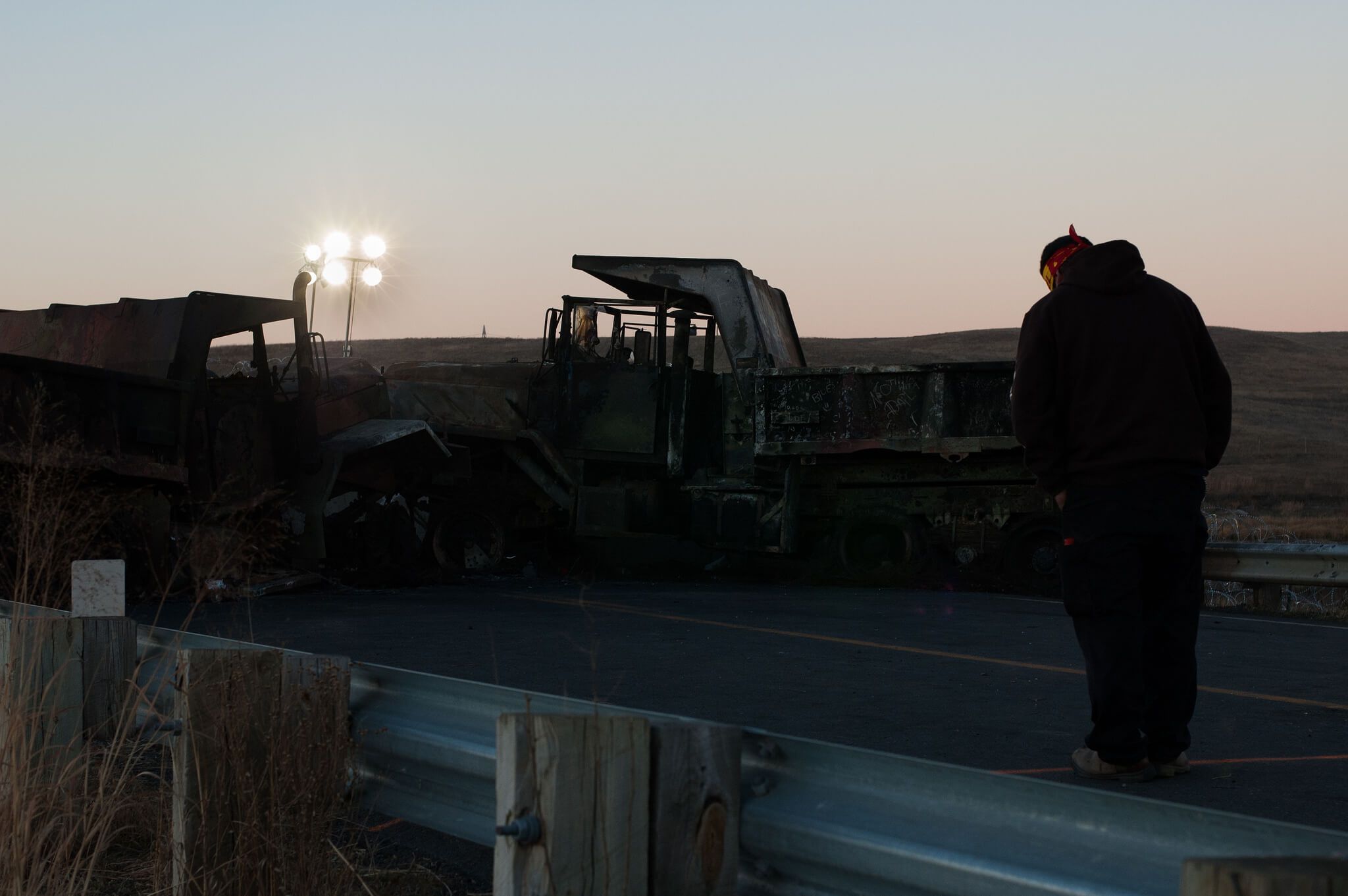
by Deep Green Resistance News Service | Jul 20, 2018 | Colonialism & Conquest
Featured image: Dakota Access Pipeline Resistance Camp, October 12, 2016. Photo: Irina Groushevaia/flickr.
by Rebecca Pilar Buckwalter Poza / Intercontinental Cry
Standing Rock protesters faced below-freezing conditions, water cannons, sponge rounds, bean bag rounds, stinger rounds, teargas grenades, pepper spray, Mace, Tasers, and even a sound weapon. Officers carried weapons openly and threatened protesters constantly, by many accounts. Hundreds of protesters were injured, and more than two dozen were hospitalized.
As of November 2016, 76 local, county, and state agencies had deployed officers to Standing Rock. Between August 2016 and February 2017, authorities made 761 arrests. One protester was arrested and slammed to the ground during a prayer ceremony; another described being put in “actual dog kennels” with “photos of the types of dogs on the walls and piss stains on the floor” in lieu of jail. She wasn’t told she was under arrest; she wasn’t read her rights. Once detained, protesters were strip searched and denied medical care. Belongings and money were confiscated, the latter never returned.
Law enforcement officers razed the camp in February 2017. The protest may have ended, but aggression against protesters did not. Law enforcement and prosecutors’ efforts to charge protesters with as serious a crime as possible have become battles to convict them and obtain the maximum sentence possible.
During a Oct. 27, 2016, roadblock protest of the Dakota Access Pipeline at Standing Rock, several fires were set. By whom, no one knew. Prosecutors charged Little Feather of the Chumash Nation, also known as Michael Giron, and Rattler of the Oglala Lakota, Michael Markus, with “use of fire to commit a felony” as well as civil disorder, anyway. The charging documents cite knowledge of “several fires … set by unidentified protesters.”
Police tactics on Oct. 27, by the way, included the use of pepper spray and armored vehicles. Law enforcement and prosecutors only became more aggressive after President Trump assumed office, at his direction.
Both Little Feather and Rattler opted to plead guilty, not because there was adequate evidence against them but because the mandatory minimum sentence would be 10 years if they were convicted at trial. That was a risk not worth taking: The Guardian has reported that surveys found 84 to 94 percent of the jury pool has prejudged Standing Rock protesters. Little Feather was sentenced to three years in prison. Rattler is expected to receive the same or a similar sentence.
A third protester, Red Fawn Fallis, pleaded guilty to charges of civil disorder and illegal possession of a firearm by a convicted felon. She was accused of firing a gun during the protest, though she said she doesn’t remember doing so. The gun in question was owned by an informant who allegedly seduced Fallis. Despite these obvious flaws, she and her attorneys opted not to risk trial, citing both anti-protester sentiment and lacking disclosure by the prosecution. She received a 57-month sentence.
The ongoing experiences of Standing Rock protesters are all the more horrifying in contrast with the recent pardon of Dwight and Steven Hammond. Trump pardoned the pair, who’ve long “clashed” with the federal government, at the behest of a “tycoon” friend of Vice President Mike Pence. Both had been convicted of setting fires on federal land for a 2001 fire, while only Steven was convicted of a 2006 fire. When the mandatory minimum sentence for the pair—who originally benefited from pro-rancher bias—was imposed on appeal, it sparked an armed standoff led by another famous family of anti-government extremists, the Bundys.
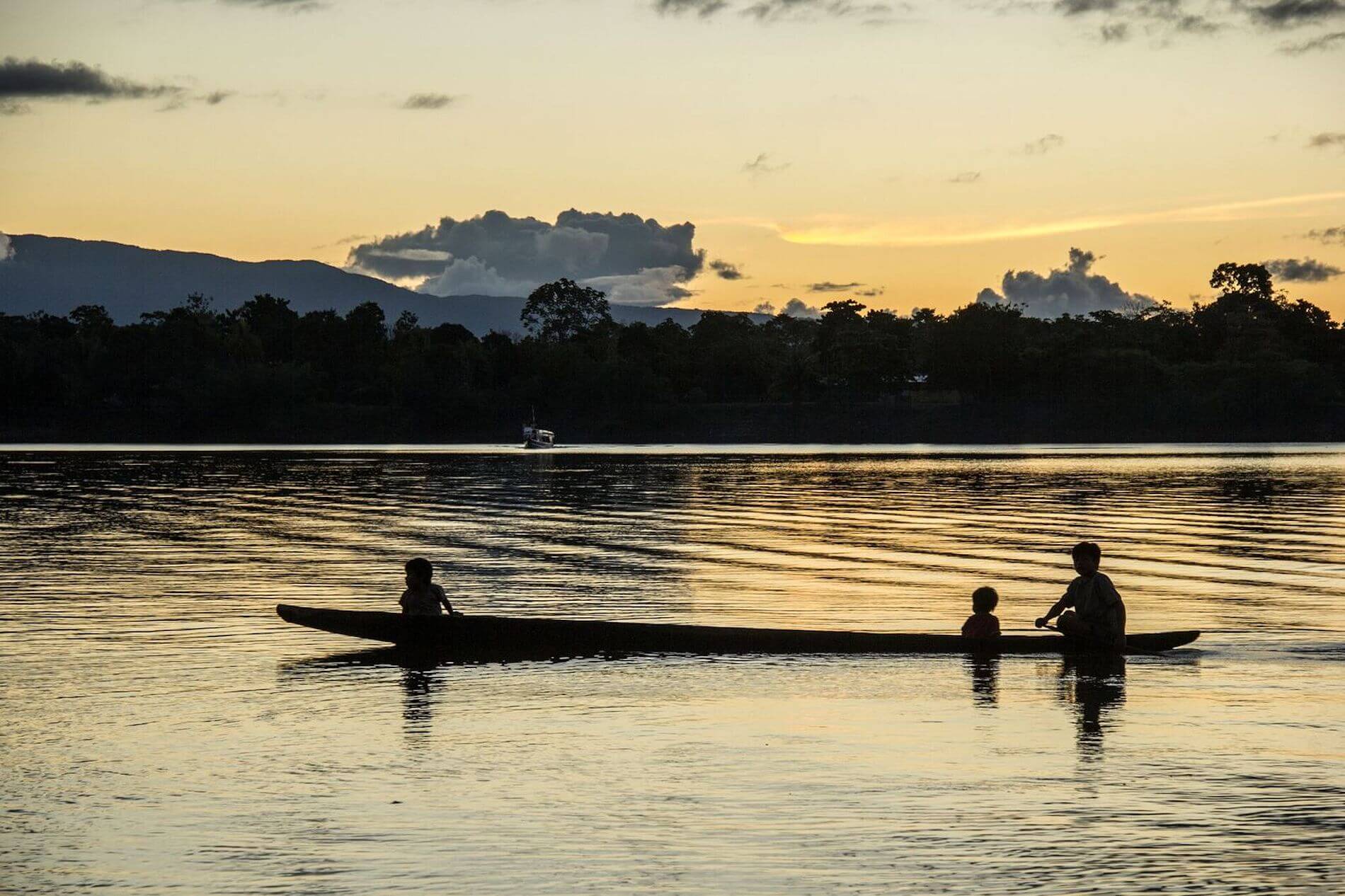
by Deep Green Resistance News Service | Jul 14, 2018 | Colonialism & Conquest
Featured image: The Shipibo-Konibo people rely on forests for hunting, fishing and natural resources. Photo by Juan Carlos Huayllapuma/CIFOR
by World Resources Institute via Intercontinental Cry
The Santa Clara de Uchunya community has lived in a remote section of the Peruvian Amazon for generations. Like many indigenous groups, this community of the Shipibo-Konibo people have traditionally managed and relied on forests for hunting, fishing and natural resources.
But in 2014, someone started cutting down large sections of the community’s ancestral forests.
Without community members’ knowledge or consent, the regional government had given away 200 parcels of land, which were then bought by palm oil company Plantaciones de Pucallpa, part of a foreign group of companies with known environmental and legal troubles.
Community members turned to indigenous organization FECONAU for help, but there was a problem: Santa Clara de Uchunya only had formal legal title to a small sliver of their ancestral lands — about 218 hectares (539 acres) out of some 8,000 hectares (19,800 acres) they occupied.
So in 2015, the community requested an extension of their title to their full ancestral lands. The Regional Government responded bymaking vague promises and implying that the existence of competing claims to the land made any action impossible. Faced with administrative inaction, the community filed a lawsuit to compel the government to recognize their constitutional rights to their ancestral land.
The lawsuit remains stuck in the courts, and the community has only been able to obtain a government commitment to a small 750-hectare extension. When officials and community members tried to complete the necessary mapping for this extension, a large crowd, presumably affiliated with the palm oil operations, blocked their path.
Community members continue to advocate, but they’ve been met with intensifying violence. Unknown armed men came to their homes, making threats like “we are ready to kill.” They beat a community member who refused to leave his land and opened fire on a community delegation trying to gather evidence of deforestation.
Meanwhile, palm oil operations continue, despite multiple injunctions ordering a halt to the company’s operations for failing to obtain proper permits and for illegally deforesting at least 5,300 hectares (13,000 acres).
“We never thought that we would have such problems with transnational companies,” said Carlos Hoyos Soria, leader of the Santa Clara de Uchunya community. “We live from hunting, fishing — from the resources that the forest has to offer. Indigenous people without land are nothing.”
Santa Clara de Uchunya’s Struggle for Land Rights Is a Global One
The story of Santa Clara de Uchunya is all too familiar. New WRI research finds that across 15 countries in Latin America, Africa and Asia, rural communities and Indigenous Peoples face steep challenges to formalizing their land rights. While they wait decades for legal titles that may never come, companies acquire land or begin operations in as little as 30 days (experience the difference in processes through our interactive infographic). The resulting conflicts over the contested land can last years, displacing communities and creating significant legal and economic risks for companies.

Indigenous Peoples and rural communities occupy more than half of the world’s land, but they legally own just 10 percent of land globally. Obtaining formal land rights is one of many tools they use to try and protect their land, but our research finds clear inequities in these procedures:
Communities face an uphill battle when trying to obtain formal rights to their land. Many communities do not realize that their customary forms of land ownership lack legal protection; those that do often lack the legal knowledge and resources to begin the process of applying for formal rights. While laws differ by country, land formalization procedures often involve difficult steps like writing technical reports or legal documents. In practice, most communities need help from an outside non-profit organization. Furthermore, as seen with Santa Clara de Uchunya, when conflicts or overlapping land rights and concessions exist, communities may be unable to title their lands at all. We found this to be a key challenge not only in Peru, but also in countries like Indonesia, Tanzania, Guyana and Mozambique.
Even when communities do obtain titles, these documents exclude ancestral lands and natural resources. Santa Clara de Uchunya’s original title was a tiny sliver of their total territory. Many communities similarly have ancestral lands excluded from their titles, with government authorities imposing arbitrary caps on the size of land they grant to communities. Elsewhere, certain types of land cannot be included in titles: in Peru, communities must complete a separate procedure if the government classifies the land as “forestland.” Even then, they can only get a contract to use their land (a cesión en uso), not ownership rights. In practice, only a few communities have been able to obtain this contract.
Some companies take shortcuts when acquiring land, with serious social and environmental consequences. Laws and policies regulating how companies obtain land are sometimes conflicting or inconsistent, leaving loopholes that companies can exploit to acquire land more quickly. Like Plantaciones de Pucallpa, which did not properly complete social and environmental licensing before beginning its operations, some companies take advantage of governments’ limited abilities to monitor for misconduct. This not only hurts communities, but also sets companies that do carefully screen for environmental and social risks at a competitive disadvantage compared to those taking shortcuts.
Getting to the Root of the Land Rights Problem
Investigating environmental crimes and problematic land transactions after they occur comes too late, and is expensive and time-consuming. A far better solution is to solve the land issues at the root of these problems. Governments should recognize indigenous and community land rights, engage in better monitoring of company misconduct during land acquisitions, and ensure that businesses secure the free, prior and informed consent of the people who live on the land before they begin operations.
LEARN MORE: Read the full report, The Scramble for Land Rights: Reducing Inequity Between Communities and Companies
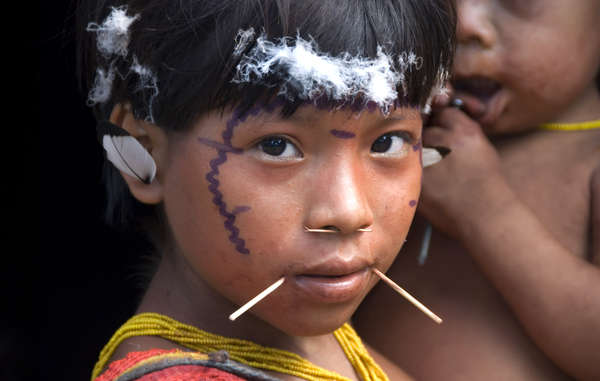
by Deep Green Resistance News Service | Jun 29, 2018 | Colonialism & Conquest
Featured image: The Yanomami are the largest relatively isolated indigenous people in the Amazon. © Fiona Watson/Survival
by Survival International
A measles epidemic has hit an isolated Amazon tribe on the Brazil-Venezuela border which has very little immunity to the disease.
The devastating outbreak has the potential to kill hundreds of tribespeople unless emergency action is taken.
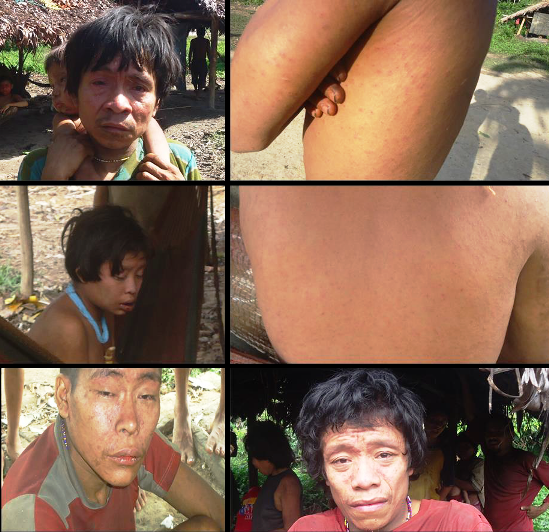
Pictures of Yanomami affected by the current measles outbreak. © Wataniba
The Yanomami communities where the outbreak has occurred are some of the most isolated in the Amazon.
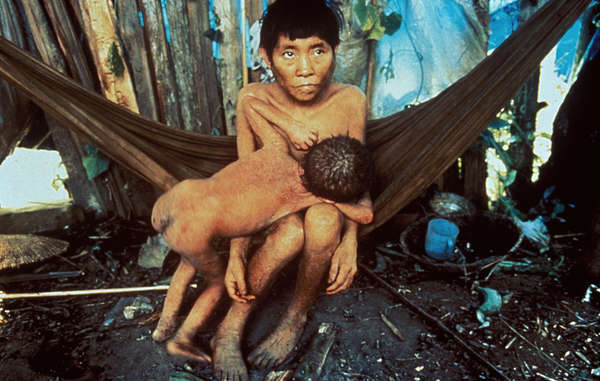
The Yanomami have previously been ravaged by outbreaks of deadly diseases following invasions of their territory by gold miners. © Antonio Ribeiro/Survival
But thousands of gold miners have invaded the region, and they are a likely source of the epidemic. Despite repeated warnings, the authorities have taken little effective action to remove them.
In Brazil, at least 23 Indians have visited a hospital, but most of those affected are far from medical care.
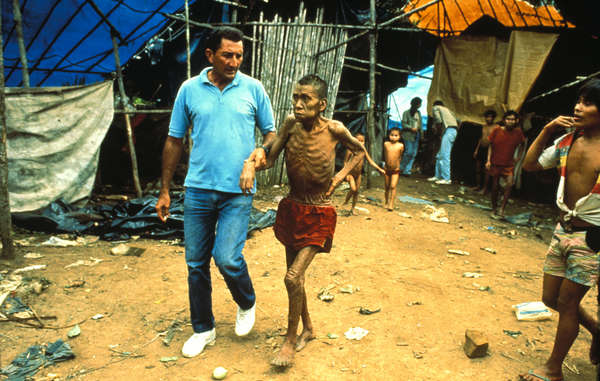
Previous disease outbreaks killed 20% of the Yanomami in Brazil. © Antonio Ribeiro/Survival
Survival International is calling for authorities in Venezuela to provide immediate medical assistance to these remote communities.
Survival’s Director Stephen Corry said today: “When tribal people experience common diseases like measles or flu which they’ve never known before many of them die, and whole populations can be wiped out. These tribes are the most vulnerable peoples on the planet. Urgent medical care is the only thing standing between these communities and utter devastation.”
The Venezuelan NGO Wataniba has released further details on the outbreak (in Spanish).
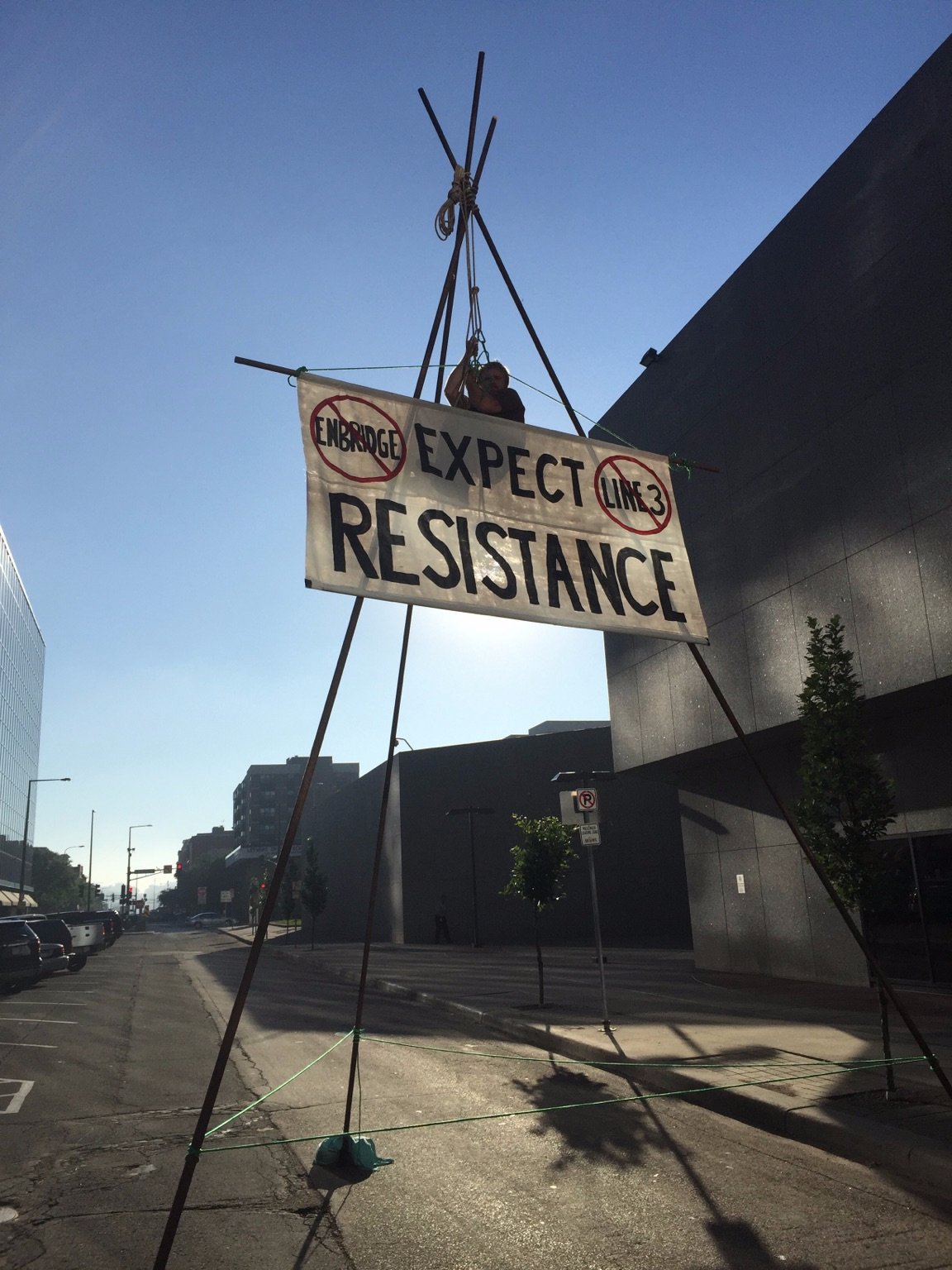
by DGR News Service | Jun 28, 2018 | Biodiversity & Habitat Destruction, Climate Change, Colonialism & Conquest, Indigenous Autonomy, Obstruction & Occupation
For Immediate Release
June 28, 2018
Activist risks arrest in front of Minnesota Public Utilities Commission Office during its final hearings to permit the Line 3 tar sands pipeline
Contact: Ethan Nuss, (218) 380-9047, stopline3mpls@gmail.com
ST PAUL, MN – A water protector ascended a 25-foot steel tripod structure erected in the street in front of the Public Utility Commission (PUC) office to demonstrate ongoing resistance against Enbridge’s proposed Line 3 tar sands pipeline. Today marks one of the final public hearings held by the PUC on its decision to grant a certificate of need to the controversial pipeline.
All five of the directly affected Objibwe Tribal Nations in Minnesota oppose the dangerous project because of the threat it poses to their fresh water, culturally significant wild rice lakes, and tribal sovereignty. Line 3 will accelerate climate change by bringing carbon-intensive tar sands bitumen from Alberta to refineries in the Midwest. Climate change disproportionately impacts Indigenous and frontline communities across the world. This deadly infrastructure project is another example of the genocidal legacy of colonialism faced by Native peoples and the ecological destruction caused by corporate greed. Water protectors, climate justice advocates, landowners, and faith leaders stand united alongside Native communities against this dangerous pipeline.
At around 7AM CST water protectors blockaded traffic by erecting 25-foot steel poles in a tripod structure on 7th Pl. in front of the PUC offices in downtown Saint Paul, MN. Ben, a 30-year-old Minneapolis resident, ascended the structure and unfurled a banner that reads, “Expect Resistance,” a clear message to Enbridge and the PUC that fierce opposition to this pipeline will continue to grow at every stage.
“If the PUC doesn’t stop Line 3, then we will,” said Ben, suspended from the 25-foot structure in the street in front the PUC. “Today’s action isn’t about me but is a demonstration of the growing resistance to Line 3. ” Ben continued, “We’re taking action in solidarity with Native people, who continue to fight for their existence on occupied land and with people all over the world who resist the desecration of nature by extractive industries.”
For photos and live updates go to: twitter.com/ResistLine3
(Update: the tripod was occupied for three years before being vacated)
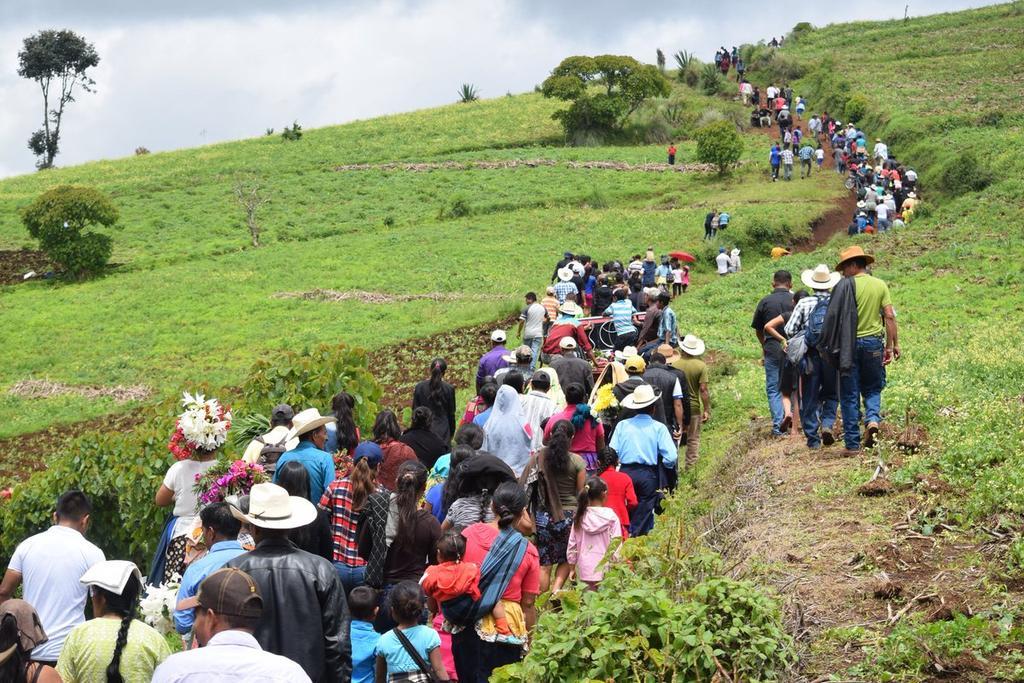
by Deep Green Resistance News Service | Jun 18, 2018 | Colonialism & Conquest, NEWS
Featured image: CODECA members march to Guatemala City from their communities to march on June 12, 2018. By @GtCodeca on Twitter.
by Cultural Survival
In the past week three human rights defenders from the Campesino Development Committee have been killed, totaling seven fatal attacks on human rights defenders in Guatemala over the past four weeks.
CODECA (by its Spanish acronym) is an Indigenous-led grassroots human rights organization that fights for Indigenous and campesino rights in Guatemala. Its main goals include improving working and living conditions of the rural poor, fighting against exploitative energy companies and engaging in political advocacy.
On June 8, 2018, Francisco Munguia was found hacked to death by machete in the Jalapa region in eastern Guatemala. Munguia, a member of the marginalized Indigenous Xinca nation in Guatemala, was the community vice president of CODECA in the village of Divisadero Xalapan Jalapa.
This comes four days after Florencio Pérez Nájer and Alejandro Hernández García, were found dead by machete attack on June 4, 2018. As human rights defenders for CODECA, they mainly advocated for farmers’ labor rights, land reform and the nationalization of electric energy.
Last month, the regional director of CODECA, Luis Arturo Marroquín, also Xinca, was fatally shoton May 9, 2018 in San Luis Jilotepeque central square when he was on his way to a training of Indigenous women. This came only a week after president Jimmy Morales made a speech that publicly defamed CODECA, which CODECA leaders believe “strengthen[ed] hatred and resentment” towards their organization.
In response to the murder of their colleagues, CODECA issued a press release, saying “While the murder of our friends hurts us dearly, it will never intimidate us. We will fight harder and more united to reach our goals and those of our deceased defenders and friends.”
In a speech from the community cemetery in Xinca territory of Xalapán, Thelma Cabrera Perez, National Director of CODECA, declared, “What we demand is the defense of our rights and to live a dignified life [and] when we organize ourselves to defend our rights, that is when we are persecuted.”
Victoria Tauli-Corpuz, the United Nations Special Rapporteur on the rights of Indigenous Peoples condemned these murders in an op-ed in the Washington Post last week, calling them evidence of institutionalized racism against Guatemala’s Indigenous Peoples. The UN has also called out Guatemala in the past for its criminalization and imprisonment of human rights defenders. Guatemala has received 17 recommendations from UN member states through the Universal Periodic Review system to combat this wave of violence; for example,
In 2012, Australia recommended Guatemala to: “Ensure effective and independent investigations into all reports of extrajudicial executions and ensure that reports of killings, threats, attacks and acts of intimidation against human rights defenders and journalists are thoroughly and promptly investigated and those responsible brought to justice’’
Often times, murders of Indigenous activists are not featured in mainstream news or media outlets, despite Indigenous activists constituting 40 percent of environmental activists murdered worldwide last year.
On June 12, 2018, CODECA supporters marched in protest to Guatemala City to “demand justice for the murder of their colleagues” and call for the resignation of president Jimmy Morales. They demand a fair investigation into the murders of those killed.
CODECA tweeted, “From the fields to the city, our southern contingency at the Trébol begins to organize. We demand justice for the assassination of our defenders; we demand the resignation of Jimmy Morales, his inept cabinet, and corrupt congressmen.”

CODECA is one of Cultural Survival’s grant partners for the community media grants project, through which it receives support for its radio programs on Indigenous Peoples’ rights, decolonization, and the establishment of a plurinational democratic nation.
Cultural Survival stands in solidarity with CODECA and firmly condemns these murders of Indigenous human rights defenders. We call for an immediate investigation into the pattern of violence against human rights defenders in Guatemala, in line with international human rights recommendations.
We join Amnesty International in demand authorities:
-
Initiate a prompt, impartial and thorough investigation on the recent killings of human rights defenders from CODECA and CCDA. The investigation should include the theory of the attack being a possible retaliation for their legitimate activities as human rights defender.
-
Guarantee the safety of all CODECA and CCDA members at risk in accordance with their wishes;
-
Condemn the killings and publicly recognize the important and legitimate work of all human rights defenders in Guatemala and refrain from using language that discredits, stigmatizes, abuses, disparages or discriminates them.
Take Action:
https://www.amnestyusa.org/urgent-actions/urgent-action-update-two-more-land-defenders-killed-guatemala-ua-97-18/













